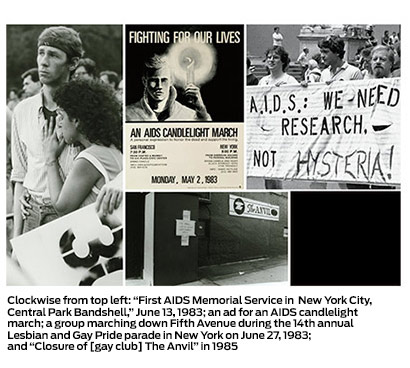On June 7, the New-York Historical Society will launch a new exhibition titled AIDS in New York: The First Five Years. On display at its Upper West Side museum through September 15, the retrospective charts the early years of the epidemic as it cut a devastating course across the landscape of the city, where many of the first cases were identified in 1981. The narrative is told through a brilliant and at times heartbreaking kaleidoscope of cultural artifacts, including photographs, posters, pamphlets, clinicians’ notes, diary entries and letters as well as audio, visual and print media. The materials were drawn from the archives of the New York Public Library, New York University and the National Archive of LGBT History.
The exhibition first examines how the 1969 Stonewall revolution led to a euphoric sense of sexual liberation among gay men in the 1970s that, coupled with other major cultural shifts and an increasingly gritty and lawless New York, opened the door for a decade of previously unimaginable sexual revelry. But as the activist Larry Kramer warned his fellow gay men with increasing ferocity in the early 1980s: The party was over. Nothing would ever be the same. (Kramer’s 1985 rage-fueled AIDS play The Normal Heart serves as a closing note to the exhibition.)
The story of those early years of rumor, innuendo, fear and panic, of young men dropping dead in the prime of their lives, along with the other members of the socially marginalized “four H’s”—homosexuals, hemophiliacs, heroin users and Haitians—is recalled in the images of their Kaposi’s sarcoma lesions, in a thank-you note to family and friends who cared for a dying man, and in images of desperate public protests calling for medical research and fighting against the crippling stigma toward people with AIDS.
Artifacts also detail the scientific community’s response to the growing epidemic, which was eventually considered a threat to those in the “general population” as well. Included is a July 1982 transcript from a Kaposi’s sarcoma conference in which a dialogue between scientists identifies the moment when the term AIDS was suggested to officially codify what had before been referred to as “gay-related immunodeficiency disease,” or GRID. A 1983 New York City health department pamphlet on AIDS shows both how much and how little was known about the disease at the time. And there is a video of the infamous April 1984 press conference in which President Reagan’s Health and Human Services Secretary Margaret Heckler announces the discovery of HIV, the imminent release of an HIV test, and the expectation that a vaccine would enter human trials within two years.
Accompanying the exhibit is a photography show titled Children With AIDS: 1990–2000, featuring 30 black-and-white photographs by Claire Yaffa, illuminating the stories of the youngest affected by the disease.
For more information on the exhibit, click here.
Advertisement
Advertisement
Advertisement






3 Comments
3 Comments